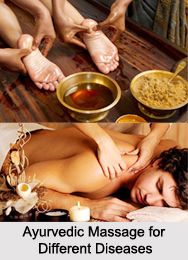 Ayurvedic massage works on both the physical and mental levels, transmitting a life-giving energy that assists all systems of the body to repair and renew themselves. Ayurvedic massage practitioners concentrate on the marmas, subtle energy points that respond to gentle physical manipulation, and work with the needs of the different body types.
Ayurvedic massage works on both the physical and mental levels, transmitting a life-giving energy that assists all systems of the body to repair and renew themselves. Ayurvedic massage practitioners concentrate on the marmas, subtle energy points that respond to gentle physical manipulation, and work with the needs of the different body types.
Massage therapy is a popular type of alternative treatment in traditional forms of medicine practiced in China, Japan, India and Egypt. As a means to prevent conditions arising from physical, mental and emotional stress, and to complement a treatment for a particular ailment, Ayurvedic massage is preferred because it offers a non-invasive means to achieve wellness and good health. It is also often recommended and used by individuals suffering from chronic conditions. Massage can cause blood to flow in and out of the joints and muscles fast and smoothly, therefore increasing the delivery of oxygen and nutrients throughout the body. In turn, this process may aid recovery time from bodily injuries in some cases.
Benefits of Ayurvedic Massage
Massage is generally considered part of complementary and alternative medicine. It is increasingly being offered along with standard treatment for a wide range of medical conditions and situations. Studies of the benefits of massage demonstrate that it is an effective treatment for reducing stress, pain and muscle tension.
Massage can reduce pain and anxiety for people with chronic illnesses, such as cancer, and reduce the physiological burden of stress. Some studies have found massage may also be helpful to treat stress-related physical conditions, including:
•Anxiety
•Digestive disorders
•Fibromyalgia
•Headaches
•Insomnia related to stress
•Myofascial pain syndrome
•Soft tissue strains or injuries
•Sports injuries
•Joint Pain
Beyond the benefits for specific conditions or diseases, some people enjoy massage because it often produces feelings of caring, comfort and connection. After the massage, one may feel relaxed and a little sleepy, or may experience a surge of energy, awareness and concentration.
Massage helps release toxins from the soft tissues, so it is recommend that to drink plenty of water after massage to flush toxins out of ones system.




















